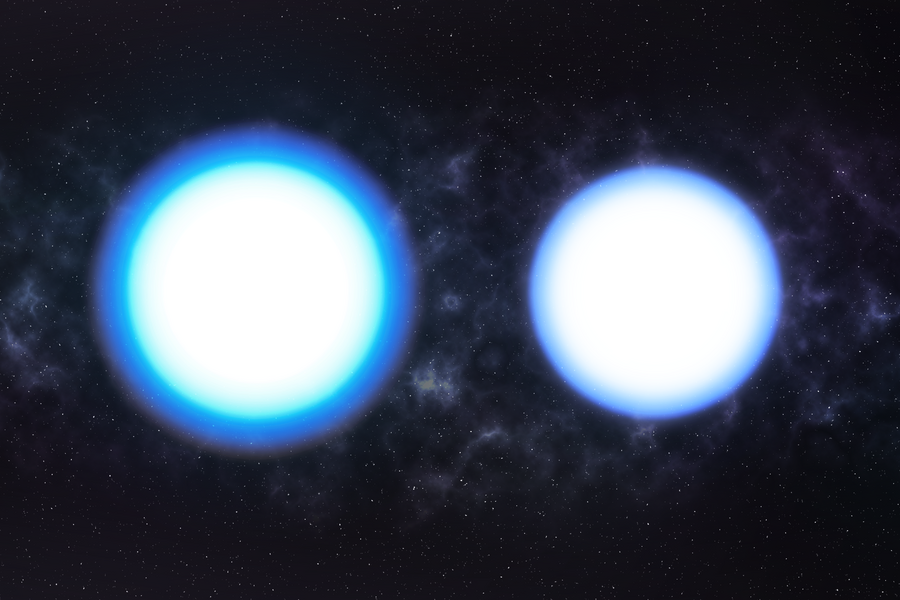- Name
- Roberto Molar Candanosa
- rmolarc1@jh.edu
- Office phone
- 443-997-0258
- Cell phone
- 443-938-1944
A study of more than 26,000 white dwarf stars has confirmed a long-predicted but elusive effect in these ultra-dense, dying stars: Hotter white dwarfs are slightly puffier than cooler ones, even when they have the same mass.
The findings bring scientists one step closer to using these stellar objects as natural laboratories to probe the effects of extreme gravity and hunt for exotic dark matter particles. Details about the research, led by Johns Hopkins University, are published in The Astrophysical Journal.
"White dwarfs are one of the best characterized stars that we can work with to test these underlying theories of run-of-the-mill physics in hopes that maybe we can find something wacky pointing to new fundamental physics," said Nicole Crumpler, a Johns Hopkins University astrophysicist who led the work. "If you want to look for dark matter, quantum gravity, or other exotic things, you better understand normal physics. Otherwise, something that seems novel might be just a new manifestation of an effect that we already know."
White dwarfs are cores of stars that were once like our sun but that have exhausted all the hydrogen once used as nuclear fuel. These stripped-down stars are so dense that a teaspoon of their material weighs upward of a ton, far heavier than ordinary matter. With that mass packed so tightly, their gravitational pull can be hundreds of times stronger than Earth's.
The research relied on measurements of how those extreme conditions influenced light waves emitted by white dwarfs. Light traveling away from such massive objects loses energy in the process of escaping its gravity, gradually turning redder. This "redshift" effect stretches light waves like rubber in ways telescopes can measure. It results from the warping of spacetime caused by extreme gravity, as predicted by Einstein's theory of general relativity.
By averaging measurements of the white dwarfs' motions relative to Earth and grouping them according to their gravity and size, the team isolated gravitational redshift to measure how higher temperatures influence the volume of their gaseous outer layers.

Image caption: The planetary nebula G164.8+31.1, named for its sky position, shows a dying Sun-like star shedding its outer layers (green and blue), leaving its core as the bluish-white star at the center.
Image credit: Sloan Digital Sky Survey
The research continues efforts by the same Johns Hopkins group. Their 2020 survey of 3,000 white dwarfs confirmed the stars shrink as they gain mass because of "electron degeneracy pressure," a quantum mechanical process that keeps their dense cores stable over billions of years without the need for nuclear fusion, which typically supports our sun and other types of stars. Until now, the team did not have enough data to confidently confirm the subtler—but important—effect of higher temperatures on that mass-size relationship, Crumpler said.
The study combines observations from the Sloan Digital Sky Survey, which uses telescopes in Chile and New Mexico, and the European Space Agency's Gaia mission. Both projects are continuously mapping and tracking millions of stars, galaxies, and other cosmic objects.
"The next frontier could be detecting the extremely subtle differences in the chemical composition of the cores of white dwarfs of different masses," said Nadia Zakamska, a Johns Hopkins astrophysics professor who directed the research. "We don't fully understand the maximum mass a star can have to form a white dwarf, as opposed to a neutron star or a black hole. These increasingly high-precision measurements can help us test and refine theories about this and other poorly understood processes in massive star evolution."
The observations could also help attempts to spot signs of dark matter, such as axions or other hypothetical particles, Crumpler said. By providing a more detailed picture of white dwarf structures, the team could use this data to uncover the signal of a particular model of dark matter that results in an interference pattern in our galaxy. If two white dwarfs are within the same dark matter interference patch, then dark matter would change the structure of these stars in the same way, Crumpler said.
Even though dark matter has gravity, it does not emit light or energy that telescopes can see. Scientists know it makes up most of the matter in space because its gravity affects stars, galaxies, and other cosmic objects in ways similar to how the sun affects our planet's orbit.
"We've banged our heads against the wall trying to figure out what dark matter is, but I'd say we have jack diddly squat," Crumpler said. "We know a whole lot of what dark matter is not, and we have constraints on what it can and can't do, but we still don't know what it is. That's why understanding simpler astrophysical objects like white dwarf stars is so important, because they give hope of discovering what dark matter might be."
Other authors include Vedant Chandra and Priyanka Chakraborty of Center for Astrophysics | Harvard & Smithsonian; Gautham Adamane Pallathadka, Stefan Arseneau, and Stephen P. Schmidt of Johns Hopkins University; Nicola Gentile Fusillo of Università degli Studi di Trieste; J.J. Hermes of Boston University; Carles Badenes of University of Pittsburgh; and Boris T. Gänsicke of University of Warwick
This research was supported by the National Science Foundation Graduate Research Fellowship Program under Grant No. 679DGE2139757, a Peirce Fellowship from Harvard University, the Johns Hopkins President's Frontier Award, a seed grant from the JHU Institute for Data Intensive Engineering and Science, the Johns Hopkins Provost's Undergraduate Research Award, the Alfred P. Sloan Foundation, and the Heising-Simons Foundation.
Sloan Digital Sky Survey telescopes are located at Apache Point Observatory, funded by the Astrophysical Research Consortium and operated by New Mexico State University, and at Las Campanas Observatory, operated by the Carnegie Institution for Science. Funding for the European Space Agency's Gaia Data Processing Analysis Consortium has been provided by national institutions participating in the Gaia Multilateral Agreement.
Posted in Science+Technology
Tagged physics, astronomy, astrophysics, physics and astronomy, student research









